Penmachine
15 September 2008
Camera Works: shutters, flashes, and sync speed
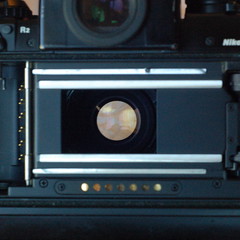 The shutter of a camera seems pretty simple. For years, I thought of it the way it's described: as a shutter curtain. You know, as a sheet (metal, cloth, whatever) near the back of the camera that behaves like this:
The shutter of a camera seems pretty simple. For years, I thought of it the way it's described: as a shutter curtain. You know, as a sheet (metal, cloth, whatever) near the back of the camera that behaves like this:
- Most of the time, it's closed, to keep light from hitting the film or digital sensor.
- Press the camera button, and the curtain swishes open (really really fast), exposing the film or sensor to light from the camera lens. Click!
- Then, it stays open for the time you set (whether 4 seconds of 1/4000th of a second).
- Finally, it swishes closed again (really really fast), returning the back of the camera to darkness. Click!
That's straightforward, especially once you have a grip on focal lengths and f-stops. But it's also wrong. Camera shutters are a bit more complicated than that, and understanding that complexity can help you make better photographs.
How does a shutter work?
If you have a point-and-shoot digital camera, or a camera in your mobile phone, you'll never see its shutter. That's partly because you can't get inside the camera to take a peek, but also partly because many small digital cameras don't even have a shutter. (I'll explain why below.)
But let's ignore that for now. In the long, long history of film photography, cameras had to have some sort of shutter, since that was the only way to achieve two important goals:
- Keeping light from hitting the film when you didn't want it to.
- Making sure that light did hit the film when you wanted it to, but only then.
Camera manufacturers spent over a century figuring out how to make shutters faster and more accurate. There have been many designs in that time. Some tried leaf shutters that are part of the lens, with blades that open like the lens's aperture. (Many medium-format cameras use in-lens leaf shutters.) But the type most photographers are familiar with is the focal plane shutter, which sits right in front of the film and, in its simplest form, behaves something like the curtain I described above.
Before the 1980s, many SLR shutters were fully mechanical, relying on springs and levers for actuation and timing. In recent years, only specialist and boutique film cameras such as the Nikon FM3a and Leica MP retained mechanical-only shutters, so those cameras are fully functional without any batteries at all, as long as you have an external light meter (or excellent intuition about proper exposure).
Higher-end modern film and digital cameras, such as all digital single-lens reflex (DSLR) models, still use focal-plane shutters. But like most film camera shutters made since the 1980s, they are electromechanical: their mechanical shutters are controlled by the camera's electronics. They always need batteries (or a power adapter) to work.
On SLRs, you can remove the lens and raise the mirror to see the front of the shutter; on film models, you can also open the back to see its rear side too. Take a look at such a shutter (mechanical or electromechanical) and you'll find that, rather than resembling a simple curtain, it consists of many parts, more like an airlock of some sort:
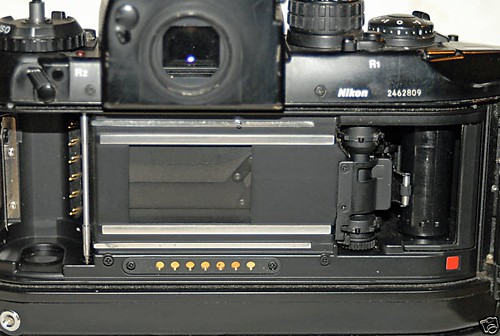
Rear view of the shutter (centre) on my Nikon F4 film SLR.
According to Nikon's promotional materials, the shutter on my F4 camera (the world's top-of-the-line professional 35 mm SLR when it was introduced in 1988) includes more than 200 components, which is more than some entire cameras of the same vintage. It remains one of the most sophisticated still-camera shutters ever made, with many miniscule levers and cams, a tungsten-alloy shutter balancer to minimize vibration, curtain components made of both metal and a carbon fibre–epoxy compound, and a maximum shutter speed of 1/8000th of a second.
Two curtains for extra speed
It's amazing that a physical shutter mechanism can open and close in 1/8000th of a second. So amazing, in fact, that it doesn't do that at all. Instead, pretty much every focal plane shutter you'll ever encounter has at least two curtains (which can comprise numerous parts each). One opens, the other closes. Here's how they're put together in my Nikon F4:
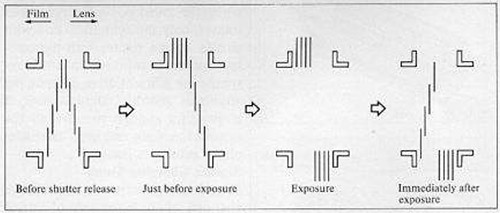
Nikon's diagram of how the F4 shutter works. Notice that there are two separate shutter curtains (one in front of the other), each made of four blades which are a fraction of a millimetre thick. The diagram doesn't show all the tiny levers, cams, springs, screws, fasteners, motors, and such needed to make this arrangement actually work. Diagram from the Nikon F4 Technical Guide, © 1988-1996 Nikon.
This shutter opens and closes from top to bottom, known as a vertical-travel design, which is also most common on modern digital SLRs and other cameras. When the camera isn't in use, both sets of shutter blades are down, keeping light from reaching the film. Here's what happens for relatively slow shutter speeds:
- When you press the shutter button, the camera's mirror flips up.
- Then the back four shutter blades slide up out of the way (very very fast), layering over each other like an elevator door opening on its side, but leaving the front shutter blades closed to keep light out. The film has not yet been exposed, but the shutter is now ready to do it.
- Next, for the actual exposure, those closed front four shutter blades slide down (very very fast) to let light from the lens reach the film.
- After the requisite interval (say 1/30th of a second), the waiting rear blades follow, sliding down again (very very fast) to cut off light to the film once more.
- When everything's done, the front blades slide back up and the mirror flips down into position.
That last move both returns the lens image to the viewfinder up above via the mirror, and makes sure no more light gets to the film, even if you bump the camera around, because both sets of curtains are closed. To see it all in the real world, you can watch a modern Nikon D3 SLR do its thing in this high-speed close-up frame-by-frame photo sequence of its focal plane shutter in action. There are also some great, informative animations of the process at Digital Photography School.
If you're looking through the viewfinder during this time, the view momentarily goes black (known as the blackout interval) while the mirror gets out of the way, so one disadvantage of SLR camera designs is that you can't actually see what you're photographing at the very instant you take the picture. But that instant is pretty short: usually something like a tenth of a second for all the flipping and sliding and springing to take place.
Many older cameras used horizontal-travel shutters, which are usually slower because the parts have to travel a bit farther. And lots of electromechanical and mechanical shutters use fewer parts, some of which may be heavier or which might move more slowly for other reasons, but they all work essentially the same way, with two curtains that follow each other to expose the film or sensor, and then cover it up again after a short time.
However, when the shutter speed gets really quick, things change a little. How fast "really quick" is depends on the shutter design and materials, but in general for SLRs, the more you spend on the camera, the quicker the shutter. Nevertheless, somewhere around a threshold of 1/60th or 1/90th or 1/125th or 1/200th or 1/250th or maybe 1/300th of a second, even the most modern vertical-travel focal plane shutters with the lightest, thinnest, best-engineered blades can't fully open and close any faster. (Start calculating the forces on those accelerating and decelerating sliding plates of metal and carbon fibre, or pieces of rubberized cloth in older cameras, as they whip open and closed really really fast, and you'll see why.)
So, decades ago, camera designers figured out a clever trick. It's not as if the entire film plane has to be exposed all at once. For a 1/1000th of a second exposure, for example, if the front curtain starts opening, and then, 1/1000th of a second later, the back curtain begins following, even before the front curtain has moved very far, then the two curtains can move across the film plane like two cars on a highway, with a gap between them.
How fast is fast?
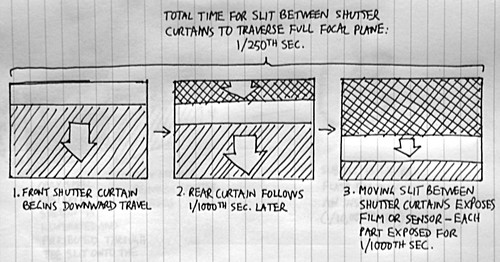
For fast exposures, the rear shutter curtain follows the front one like a drafting car on the highway, creating a moving slit of light.
The gap is then a narrow slit of light moving across the film (top to bottom or one side to the other, depending on the shutter design), which means that while the slit of light can take a relatively long time to cross the gap, any particular slice of the film (or digital sensor) only gets exposed for a short fraction of that time. The slit can move at 1/60th of a second on some old mechanical cameras, or more like 1/200th or faster on modern DSLRs—but any particular slice of the film (or digital sensor) only gets exposed for 1/1000th of a second as the slit passes over it.
High-end professional shutters like the one on my F4, and even on new pro cameras like the Nikon D3 and Canon EOS 1D Mark III (Canon, please clean up your camera names!), can fully open and close as fast as 1/250th or 1/300th of a second, and their maximum shutter speeds go up to 1/8000th of a second, which means the slit passing over the focal plane is really, really thin. Those maximums have been about the same since at least 1988, so electromechanical focal plane shutters reached some sort of physical limit a couple of decades ago.
(Okay, that's not quite true. Minolta managed 1/12,000th of a second with an even-narrower slit in 1992. The Canon 1D could open and close in 1/500th of a second, and maxed out at 1/16,000th, but it had a hybrid shutter like those I talk about below. No current DSLR, especially the full-frame variety, comes close to that.)
You can imagine a few circumstances where this design could be a problem: freezing photos of really fast-moving objects (nearby aircraft, for instance) requires fast shutter speeds. Even 1/250th of a second might be slow enough to blur a passing jet. But a faster shutter speed doesn't really move the shutter mechanism faster, so the moving-slit design could theoretically smear out the final image if the object is moving fast enough and you're not moving the camera to follow.
So, again in theory, a fast passing airplane could be in different positions as the slit moves, smearing differently if the jet is moving with or against the direction the slit travels. However, in practice that almost never happens, even for supersonic jets, unless you are a specialized technical photographer. But in the early days of photography, it happened more frequently:
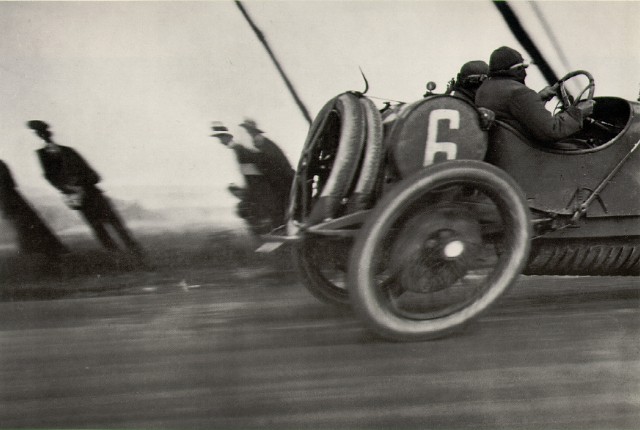
In the comments below, Andy Baird pointed me to this famous photo, which he noted "was taken by Jacques-Henri Lartigue in 1913. His large vertical shutter couldn't move very fast, so the wheels in the photo are ovals, because they were imaged as a series of horizontal slices." The racing fans are even more distorted because Lartigue was panning to follow the car. It's a great effect, even if it wasn't intentional.
The same effect is common when capturing motion using some electronic camcorder video shutters, or even with the live-view video mode on the new Nikon D90. It's noticeable enough there that reviewers have called the resulting video jello movies.
The main circumstance where the slit is a problem for most of us is when we use a flash. So camera manufacturers generally make it impossible to take flash photos with really fast shutter speeds. Mostly. Here's why.
How does a flash work?
If you took photographs with inexpensive cameras in the 1970s or earlier, you remember flashbulbs and flashcubes: expendable, single-use (or maybe four-use) flashes that attached to your camera, and which basically created a contained explosion (with audible paf!) to illuminate your pictures. They were slightly safer descendants of the flammable flash powder used by old-timey photographers.
Those flashes were good for lighting up a dark room, but didn't freeze action very well, because they took a fraction of a second to heat up (requiring the camera to wait a moment after you pressed the shutter release before it really opened the shutter) and lasted about 1/30th of a second before fizzling out. On the good side, when using a moving-slit shutter for faster exposures, a flashbulb was essentially "on" for the entire time the slit moved across the film—as far as the film was concerned, an old-style flashbulb was the same as any continuous light, like a studio lamp, a bright house fixture, or even the sun. You could use a flashbulb at any shutter speed, no matter how fast (though some of the light was wasted at faster exposures).
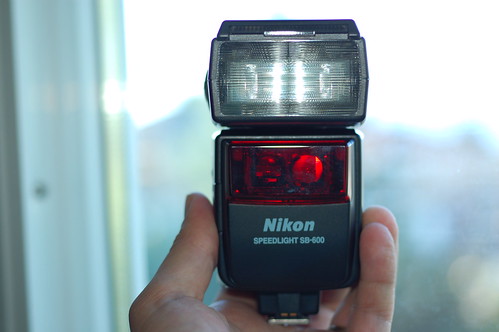
My Nikon SB-600 Speedlight flash, a modern descendant of the first strobe flashes of the 1960s.
But in the 1960s Nikon came out with what was generally a much better design: strobe flashes that they called (and still call) "Speedlights." Other manufacturers soon followed. By electronically creating a small, high-voltage electrical arc, like a lightning bolt, inside a sealed tube of inert xenon gas, strobe flashes generate a powerful and very brief pulse of light.
Speedlight flashes are great. They run on batteries, are quite power efficient, and last for thousands and thousands of pulses before they wear out. Nearly every modern camera (except mobile phones) either has an electronic strobe flash built in, or has a "hot shoe" you can attach one to.
These modern electronic flashes also freeze action very well, because their pulses last at most 1/1000th of a second. At lower powers, the burst can be 1/10,000th of a second or even substantially less (the only way for the strobe to emit less light is for the flash duration to be shorter). So, most of the time, as far as an electromechanical shutter is concerned, flashes are now instantaneous: rather than being "on" the whole time the shutter is open, they create an instant "pop" of light at some time during the exposure, usually timed to be just as the shutter opens.
And so we run into our moving-slit problem. If your flash is instantaneous, at fast shutter speeds where a slit is moving across the film or sensor plane, the flash "pop" will only send light through the slit, and only during part of the exposure:
- If the flash is being used to light up a dark image, the resulting photo will be totally black except for one flash-lit band across the image.
- If there is some ambient light and you're using the flash for "fill," there will be a bizarre stripe of bright flash-lit exposure across an underexposed background image in the rest of the frame.
Neither is what you want.

If the moving shutter curtains only expose a slit of light to the near-instantaneous flash pulse, only that slit gets recorded on the film or digital sensor. The rest of the frame stays black or underexposed. That's bad, so modern cameras make it almost impossible to do.
Flash sync, or X-sync
So, you only want to use a strobe flash like everyone has now when the shutter is completely open, and you can only do that if the exposure is at or slower than the threshold speed we talked about above, when the rear curtain doesn't start moving until the front curtain is already all the way across the focal plane. On an old camera that could be 1/60th of a second. On a top-of-the-line pro DSLR, it might be 1/300th of a second.
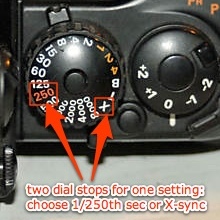 That value is so important that, ever since the Speedlight revolution of the '60s, camera makers have called it the flash sync speed of the camera: the fastest exposure you can set where the focal plane shutter is completely open for at least an instant, during which the flash can fire and expose the entire frame. On some cameras with a shutter-speed dial, that value is either highlighted in red or indicated with an X (or, on my F4, both!), so it's also called the X-sync speed, or just the sync speed.
That value is so important that, ever since the Speedlight revolution of the '60s, camera makers have called it the flash sync speed of the camera: the fastest exposure you can set where the focal plane shutter is completely open for at least an instant, during which the flash can fire and expose the entire frame. On some cameras with a shutter-speed dial, that value is either highlighted in red or indicated with an X (or, on my F4, both!), so it's also called the X-sync speed, or just the sync speed.
The slit exposure problem is sufficiently undesirable that "newer" cameras (i.e., most made in the last 25 or 30 years) generally won't even let you try to use a flash at shutter speeds faster than X-sync—they'll force the flash sync speed on you no matter what you do. If you turn on, flip up, or mount a flash on your camera, chances are it will set the shutter speed to the sync maximum (1/60th or 1/90th or 1/25th or 1/200th or 1/250th of a second, or whatever, depending on your camera). It will do that no matter what shutter speed you've told it otherwise, often even in fully manual mode.
Slower exposures are also fine with flash, and give you lots of creative options, from using fill flash to balance out harsh shadows, to creating nice motion blur while still freezing your main subject in sharp focus. Some let you control the flash's power, pre-pulse the flash to reduce "redeye" in your subjects (by making their pupils contract before the true exposure), or determine whether to fire the flash either when the shutter first opens or when it starts to close ("rear-curtain sync") for different effects. Therefore, cameras happily let you use flash at shutter speeds slower than X-sync, while blocking you from those that are faster.
Except when they don't. Which brings us to our last topic.
Wait a minute! My camera can use a flash at faster shutter speeds!
Here's a funny thing. My Nikon D50, an entry-level digital SLR introduced in 2005, has a 1/500th of a second flash sync speed. So did its predecessor the D70, and even the D1 from way back in the year 2000, as well as the newer D40. But other Nikon models (both old and new, many of them much higher-end cameras like the D3), have X-sync speeds of 1/180th, 1/200th, or at most 1/250th of a second.
Even the D40x and D60 offer only 1/200th flash sync, even though they are otherwise barely different from the D40, with its 1/500th sync! Other manufacturers show similar discrepancies. And even cheapie point-and-shoot digicams sometimes have flash sync faster than 1/250th of a second. Cameras costing $5000 and up, whose shutters have much higher total top speeds of 1/8000th of a second, have slower flash sync than cameras costing $600, or even $200! WTF? Is this a ripoff?
(Hint: no.)
Here's another funny thing. Some camera-flash combinations, usually on DSLRs using higher-priced external flashes from the same manufacturer, offer what they call "High Speed FP" (Focal Plane) mode, or something similar. With those setups, in most circumstances, flash photography is still limited by the usual X-Sync speed of 1/250th of a second or slower, but if you put the camera and flash into a special high-speed flash mode (controlled either from the flash, or from the camera, or both), you can use the flash at any shutter speed the camera supports, right up to 1/8000th of a second. But you have to specifically invoke that mode. If it offers unlimited flash sync, shouldn't it be on all the time?
(Hint: no.)
Let's tackle these two puzzles in order.
Flash sync with electronic and hybrid shutters
I mentioned back at the beginning that many point-and-shoot digicams, as well as all mobile phone cameras I know about, don't have shutters at all. Their instruction manuals might say they have shutters, but they don't: the digital image sensor is always exposed to light from the back of the lens—except when the lens cap is on or, as in many of those devices, if the lens aperture closes down when the camera is turned off.
Instead of an electromechanical shutter with light-blocking blades, these cameras have what is misleadingly called an electronic shutter. When you press the button to take a picture, the camera electronics briefly turn the sensor electronics on then off again. The sensor stays on for the exposure interval (1/30th of a second, or 1/1000th of a second, or whatever), so it's also a bit misleading to call it a "shutter speed" anymore, but we do out of tradition, and to be consistent.
This is a completely new way of doing things: film, of course, was always light sensitive and had to be kept out of the light right until it was processed. Electronic sensors can be told when to be light-sensitive, and can also turn on and off very quickly. And since there's no moving slit of light from shutter blades, if you're using a flash, it can fire and expose the whole sensor surface to light at once. So why don't all digital cameras use electronic shutters and get rid of those old mechanical ones once and for all?
There are always compromises with technology, especially in photography. Electronic shutters—or, more accurately, switchable digital light sensors—are complicated, because in addition to all the individual light sensor pixel photosites, microlenses, electron storage wells, and circuitry to move the data from them to the camera's electronics, they need additional electronics to control the switching.
The switching circuits take up space on the sensor surface, which means that:
- The manufacturer can't pack as many megapixels onto the sensor, or
- It won't be as sensitive to light because it captures fewer photons (meaning it doesn't perform as well photographing low-light scenes), or
- The images it produces have more noise in them.
Or all three. In addition, there are different types of sensors, such as CCD (Charge-Coupled Device) and CMOS (Complementary Metal Oxide Semiconductor), with different sub-types in each of them, some of which are more or less suitable to including electronic shutter technology, at least with current manufacturing processes.
There are also different types of electronic shutters, with some (called rolling shutters) that behave a bit like the film slit, or like the scanning electron gun of an old cathode ray tube (CRT) television, "painting" the image from top to bottom. That sets its own limit on how fast the shutter speed can be with a flash.
Finally, since the camera sensor remains exposed to light even when it's not turned on, unusual lighting situations, such as having the sun in the frame, can overload photosites and cause nasty "blooming" effects (scroll down here to see an example) that are at least as obnoxious as the slit-flash problem, as well as more subtle artifacts like banding or uneven noise.
As a clever compromise, on some lower-priced digital SLRs, camera makers have chosen hybrid shutters that use both focal plane curtains and switchable sensors. So for fast 1/500 flash sync, my Nikon D50 performs a neat trick:
- It opens its electromechanical shutter blades the usual way for an SLR, but relatively slowly (maybe 1/125th or 1/180th of a second, I'm not sure)—but the sensor is still turned off.
- While the shutter is open, the sensor turns on briefly for 1/500th of a second, like the electronic shutter on a point-and-shoot camera.
- While the sensor is on, the flash fires.
- The sensor turns off again.
- Lastly, the shutter closes again at its leisurely pace.
While that can cause a few image quality problems, such a design let Nikon install a less expensive, slower shutter while still offering faster 1/500 flash sync. However, it seems that such a design was only possible on the 6-megapixel CCD sensor used on the D70, D70s, D50, and D40. Once the company started using 10-megapixel sensors for the D40x and D60, those cameras had to revert to the normal electromechanical-only shutters with 1/200 sync.
So, in short, electronic shutters have various compromises. Currently, quality higher-resolution sensors that work well in low light also don't have the circuitry to act as electronic shutters, even in hybrid designs. So, for cameras where reliable performance, image quality, and low-light handling are most important, manufacturers continue to use old-fashioned electromechanical bladed shutter curtains, at least for now.
High-speed flash sync
With some higher-end external flashes, certain SLR cameras support what's known either as High Speed Sync (Canon, Sony, and others) or FP Sync (Nikon), which lets you take flash photos at any shutter speed the camera supports, right up to 1/8000th of a second. That's especially useful when using fill flash in daylight, particularly with high-powered telephoto lenses in wildlife or sports photography. How you set up High Speed Sync depends on your particular camera and flash: the controls might be on the flash unit, or in the camera menus, or both.
How is it that the High Speed Sync gets around the slit-flash problem and the traditional X-sync limit I've been talking about this whole time? It's not magic. Remember that the reason X-sync is an issue is that the flash burst is effectively instantaneous, and so only illuminates the focal plane through the moving shutter slit at one moment, rather than the entire time the shutter curtains are moving.
But newer strobe flashes can fire repeatedly, and do so in extremely rapid succession. In High Speed Sync mode, the flash fires its near-instantaneous bursts of light over and over, thousands of times per second, for the entire time the shutter slit crosses the focal plane. Effectively, in High Speed mode, the flash fires repeatedly like a machine gun, paf paf paf paf paf..., and acts like it's "on" for the entire X-sync time of 1/200th or 1/250th or 1/300th of a second, even though the exposure for any given slice of the sensor might be only 1/8000th of a second at top shutter speed.
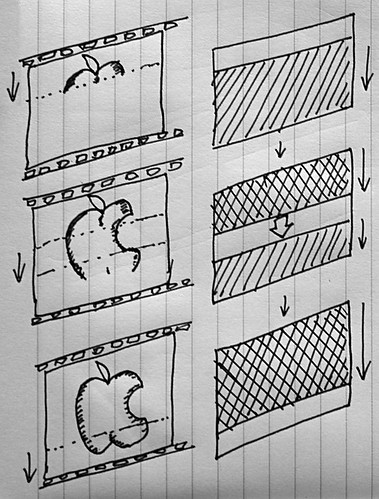
With the flash firing repeatedly thousands of times each second in High Speed mode, the light on the subject is effectively continuous, like a lamp or the sun. Flash illumination passes through the slit the whole time it is moving across the focal plane, so the entire subject is exposed to the film (or sensor) behind the shutter.
There are problems with that approach. It wastes a lot of light and power compared to the usual single flash burst, so the flash unit heats up, takes longer to recharge, and drains its batteries much faster. That's why it's not the default setting, and why only more powerful external flashes support it. A small pop-up flash on a DSLR that tried to fire repeatedly at full power might even melt, or at least suck the camera's battery dry pretty fast.
Old technology even in modern times
All current digital SLRs, as well as esoteric cameras like the Leica M8 digital rangefinder, use an electromechanical shutter of some sort, either as a hybrid design combined with an "electronic shutter" switching sensor, or with the traditional shutter alone. Most of the time, the old problem of the moving shutter slit still forces us to use a slower X-sync when taking flash pictures on DSLRs, even when cheaper point-and-shoot cameras can sync at higher speeds using electronic shutters. High Speed/FP Sync modes on DSLRs are one answer, but they are power hungry and only work with higher-end external flashes for some cameras.
I'm sure engineers at Canon, Nikon, Sony, Olympus, Pentax, and others are working on new ways to make flash sync speeds faster again. Electromechanical shutter designs started to hit their physical limits 20 years ago, but at the moment, having "slower" X-sync speeds of 1/200th or 1/250th or 1/300th of a second is a reasonable tradeoff with modern high-resolution, low-light digital sensors. Focal plane shutters have a century of design refinement behind them, and have proved reliable over decades of hard use, so they're not ready to be sidelined just yet.
Read more
Some useful resources:
- Wikipedia: The Science of Photography
- Thom Hogan: How digital cameras work
- Why digital cameras have mechanical shutters
- Nikon D3 focal plane shutter in super-slow motion
- Sync speed explained
- Photo.net forum: Mechanical vs. electronic shutter (image quality and sync speed)
- Photo.net forum: Mechanical vs. electronic shutters in DSLRs
- Wikipedia: Electronic flash
- Ken Rockwell: Sync speed
- High-speed sync for flash at any shutter speed
- Strobist: Control your world with ultra-high sync
- Photography 101.6: Shutter
« Previous: crop factors and "35 mm equivalent" lenses
Labels: barcamp, cameraworks, geekery, photography
Comments:
Chella
https://chella.info
Webmediaconsultant, India
Regarding FP mode flash: Russ MacDonald, at https://nikonclspracticalguide.blogspot.com/2008/03/10-auto-fp-high-speed-sync-explained.html, says that FP is not very useful because it provides diminished flash power. In some circumstances, one might work around this constraint by using multiple speedlights to achieve sufficient illuminance.
I did hear that there was a problem with 'soft start' in other words the total exposure is correct but loged thoughout the time it is not linear. If this is true then it could affect flash performance quite a lot with studio work. The Studio flash is - say 1/5000 second and the shutter speed 1/500. Should the flash fire at the (soft) start of the exposure the flash would be off before the CCD was fully sensitized. Any thoughts?
https://www.masters-of-photography.com/images/full/lartigue/lartigue_car_trip.jpg
The photo was taken with a 4x5 Speed Graphic with a vertically moving FP shutter. Such a large shutter couldn't move very fast... so just as you describe, it achieved high effective speeds by the "moving slit" technique. The result: the wheels in the photo are ovals, because they were not instantaneously imaged--rather, they were imaged as a series of horizontal slices, moving from bottom to top as the car moved from left to right.
Today's faster shutters make such obvious distortions rare, but the Lartigue photo nicely illustrates the principles you're discussing.
I have bought a 2nd hand F4.
I am trying to test the shutter curtain opening. I have no film inside. How do I open the shutter and keep it open?
I have tried setting it to 'B' and 'T' with no success. The film spool seem to rotate every time I press the shutter button...
Thank you in advance,
Boris
Oh, and also make sure you're in a mode where the shutter dial will do something, like M (manual) or S (shutter priority).
Hit the shutter button, and you should see the back of the camera through the lens opening while the shutter opens. B and T should also work, so if they don't, something may be wrong.
Email me if you have further questions.
It seems to be working.
My previous experience was with FM2/FM3A. They allow with the back open, I think, to keep the shutter curtain open.
Thanks again for the speedy reply.
Boris
I would give it all the available stars... Excellent write-up...
Saved it on my lap top (just in case the link disappears one day...)


